Ora Washington: The 'queen of two courts' whose brilliance was ignored
Last updated on .From the section Sport

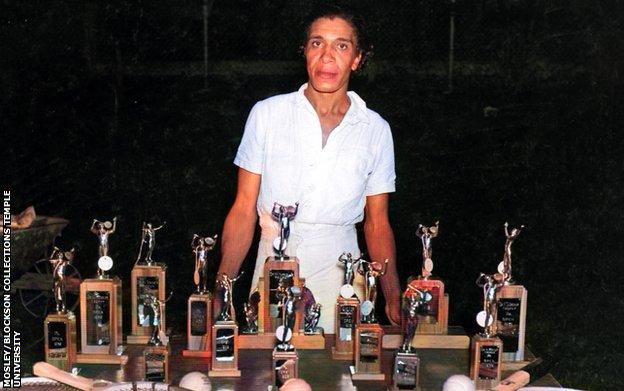
At a glitzy downtown New York hotel, the recently founded Black Athletes Hall of Fame was holding its annual ceremony.
It was March 1976 and the host was giving a speech about the latest inductee. You probably won't know her name.
Ora Washington was a champion, a star of two sports, but prejudice stopped her competing for the biggest prizes of the day. Her sporting career spanned three decades of change in her native United States, but change didn't come quickly enough.
Washington retired from tennis and basketball in the 1940s. In the mid-1970s a new generation started to dig deeper into her story. Hence the gathering in New York.
As the host finished introducing Washington to those gathered for that glamorous occasion, they started on something new: an apology.
Washington wasn't there. There was a chair placed out on the stage for her, empty. The host said they were sorry but they hadn't been able to track her down.
The New York Times wrote in its report the next day: "The silver bowl, gold ring and medallion she was to receive have been returned to the Hall of Fame offices in New York. And Miss Washington's whereabouts remain a mystery."
What nobody seemed to know was that Washington had already been dead for five years.
BBC Sounds and the BBC World Service have made a podcast series about Washington's life. You can listen to episodes here.
Part of the motivation behind doing so was to get her story out there where it belongs, so it's not forgotten.
Washington's is a powerful and important story. She was one of the most extraordinary Black female athletes of the 20th century. Tennis great Arthur Ashe described her as "the first Black female to dominate a sport".
There are still lots of things we can't know about Washington, but we do know she received homophobic abuse, and that racism and white supremacy denied her both the opportunity and recognition she deserved.
Washington's life threw up obstacles all along the way. And she took on the same types of injustice that many are still fighting today.

Washington was born in January 1898 or 1899 - the records aren't clear. Her early life was spent in a small farming community called File in Caroline County, Virginia.
Hers was a large, tight-knit family, and they owned a farm. They'd built up some economic independence by the standards of the day. Historian Pamela Grundy, who contributes to the podcast series, went there some years ago and found out Washington was the fifth of nine children.
Grundy tracked down JB Childs, Washington's nephew, who shared his memories of the farm.
"They grew tobacco, corn wheat, rye and all sorts of vegetables," he told her. "Tobacco was the biggest money strike. They raised tobacco and sold it in the winter - always have some for Christmas, whoever needed it. That's the way they made a living."
My own family has its roots not too far away. My mom's grandma was born just a couple of years after Washington, in the neighbouring state of West Virginia. She was also raised in a farming area, and also under the Jim Crow laws.
As residents of Virginia, the Washingtons lived under a web of legislation ensuring they would remain second-class citizens at every stage of their lives - formal segregation by race.
Some examples: in 1900, when Washington first appeared in the United States census, Virginia passed a law forcing railroad companies to provide separate cars for Black and white riders. Another law did the same for steamboat passengers. Schools were segregated too - but not equal.
Stories get passed down through families about those times in the South. It goes deeper than the law. We're talking about a whole culture of fear, touching every part of normal life. Fear of violence, fear of persecution.
In 1910 the census man paid another visit to the farm, 10 years on from the last. This time, Washington is listed as 12 years old. Her mother is not listed. Her father is now a widower.
When I picture that little girl growing up, living with dad and grandma and her brothers and sisters, with money short, I know they had to be hard times.
And that's why I think what happens next makes a lot of sense.

At this time in the US there is a mass movement taking place. A movement that changed a nation.
Across the first quarter of the 20th century, Black American people were leaving the South and heading for the cities and jobs of the North: New York City, Chicago, Detroit, Philadelphia and many others. What historians call 'The Great Migration'.
We can't be sure when, but sometime in the 1910s a teenage Washington packed her bags and left the old family farm, and the South, for good.
She took the train north to Philadelphia to join her Aunt Mattie, stepping into the big city for the first time, into a new life. The world she was entering was rich with newly emerging opportunities that previous generations of women - particularly Black women - never had, including organised sport.
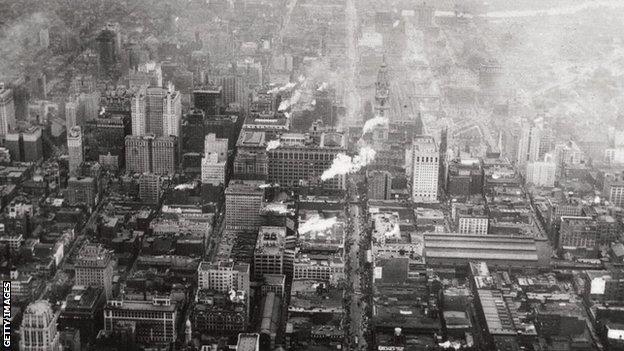
When Washington next appears on the US census in 1920, she is listed as the younger of two servants working in a wealthy white home in the Philadelphia suburbs.
Her introduction to tennis may have come around the same time, in the north Philadelphia district of Germantown, a place where new arrivals to the city - Italian, Irish, Black American - made their homes. She took lessons in the game at a branch of the Germantown Young Women's Christian Association (YWCA) set up to "make possible" for girls and women of colour the "advantages of so long enjoyed by the white girls and women of our community".
Further detail of this time is thin on the ground. We don't have any surviving letters, and the few who interviewed her during her sporting career didn't publish anything about her personal life.
However, there are surviving reports from Black newspapers like the Philadelphia Tribune - the oldest in the US (it was founded in 1884) and still publishing now.
One article implies Washington first began competing in national Black women's competitions in 1923, possibly just a few years at most after first picking up a racquet. Another account describes her unique way of holding the racquet - almost halfway up the handle - and another the power of her volleys.
Whenever she started, it's clear she was a natural. She would very soon take the sport by storm.
In 1925, Washington scored a huge victory by beating Isadora Channels, twice a winner of national championships organised by the American Tennis Association (ATA), a Black national tennis organisation founded in 1916.
It marked the start of her evolution as a player. She would move from being seen as a successful athlete to a once-in-a-generation talent.
Also in 1925, the same year as her victory over Channels, Washington won her first tennis ATA doubles title. She went on to win that title every year up to 1936. In the singles game she would win the women's ATA trophy from 1929 to 1935. Seven years as champion at the top.
Washington was a headliner who dominated Black sports media coverage, but this was still pre-war America. In contrast to another serial champion of this time - the white player Helen Wills, who won her seventh national title in 1931 - Washington's success was allowed to exist only in isolation. Not until 1950 would an African-American participate in the US Championships Wills was dominating - we know that tournament today as the US Open.
There would be no mainstream superstardom, no merchandising or endorsement deals from international sportswear brands. The competitions she won didn't lead to global fame or untold riches.
The next US census shows it. In 1930, Washington was working in Chicago as a hotel maid.
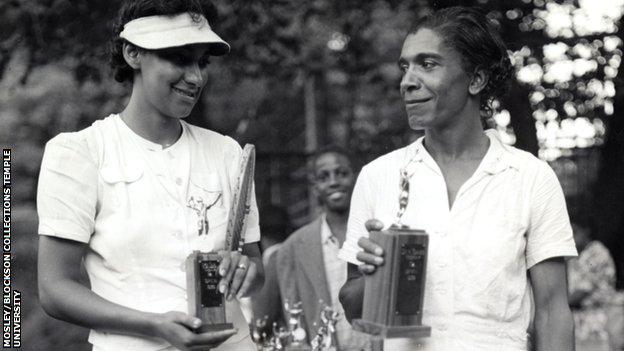
Around the time of Washington's big tennis breakthrough in 1925, her name was also beginning to appear on lists of Black women's basketball teams as well.
By the end of the 1920s she was competing almost as much in basketball as in tennis, right at a time when she was picking up multiple tennis trophies across the country and building a reputation as the best Black female player in the US.
One of the first basketball teams Washington played for was the Germantown YWCA Hornets - a so-called 'Black Fives team' or 'Black Quint' - 'Black' because these teams were only for Black players.
She became a star as the team steadily rose. Reports of the day speak of outrageous long shots, of record scores that carried her side to victory. On 9 April 1931, the Hornets claimed the National Girls Basketball Title, beating Rankin Femmes, a team from near Pittsburgh, in the final.
Mirroring her achievements in tennis, Washington had become the kind of basketball player people look forward to watching on the court.
The Philadelphia Tribune saw an opportunity and decided to sponsor a team. The Philadelphia Tribunes were coached by a prominent local activist called Joe Rainey - whose grandfather, also Joseph Rainey, was the first Black person to serve in the United States House of Representatives.
The Tribunes stood for more than sporting excellence, more than just advertising a local newspaper - or even about collecting trophies.
"Sport was seen as a really important place to argue for civil rights, in particular because sports was a performance of meritocracy, at least, in theory," says Dr Amira Rose Davis, assistant professor of history and African American studies at Penn State University.
"It was a place that many Black civic and political leaders saw as an opportunity to expand and demonstrate how Black folks were fit for citizenship."
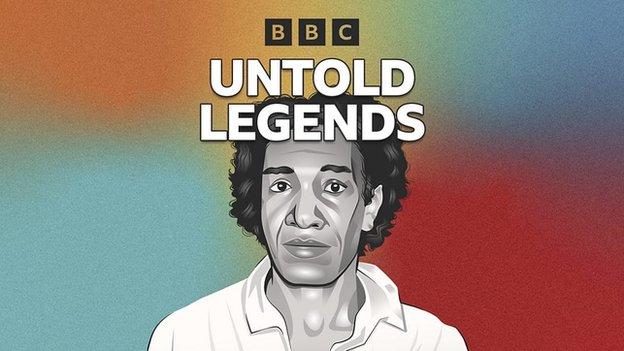
In 1932, Washington was recruited as captain of the Tribunes. The Tribune newspaper celebrated her exploits, holding her up as the star of a team that won 11 consecutive championships.
But despite this, at a time when sporting celebrities had already begun to emerge, there was never any coverage of her private life. Such focus did fall on other female athletes of the day - but only in a particular way. Washington did not fit that template.
"There was this policing of their sexuality, of their femininity," says Dr Rose Davis.
"Think of Black baseball player Toni Stone. They did a spread in a Black magazine about her and featured her in a dress because they wanted to show that she still was domestic.
"They had a picture of her without her shirt on, laying down, getting rubbed down by her husband so they could demonstrate she was still heterosexual."
Whether Washington privately saw herself as more masculine or feminine, or as heterosexual or homosexual or anything else, is impossible to know from this distance. But some former members of the Bennett College team - against whom Washington played - shared memories of her when interviewed in the early 2000s by Rita Liberti, another contributor to the podcast.
From what they said, Washington was seen as different - as less feminine than the other players.
While playing for the Tribunes, for the first time in her life Washington started to receive a small salary from sport. But she never was paid enough to give up the day job.
She would continue working in domestic service as her dual sporting careers wound down, into the 1940s. When the time did come to retire, she didn't bow out quietly.
In 1936, Washington lost the ATA singles title she'd held since 1929. The next year she won it back. She was 38, it was a fine time to step away. She announced her retirement from tennis singles, and sounded ready.
"It does not pay to be national champion too long," she told the Baltimore African-American in a rare surviving interview.
"It's the struggle to be one that counts. Once you've arrived, everybody wants to take it away from you."
However, in 1938 a new force emerged, a young player named Flora Lomax, who seemed to talk up a feud with Washington in the press.
Things became so heated that in 1939 Washington came out of retirement just to beat Lomax at a tournament in Buffalo, before shortly after retiring again, a remarkable final effort.
Washington would continue playing doubles tennis though, right up until 1948, when she was 49 or 50.
Her final title came in the mixed doubles at the ATA championships of 1947. On the opposite side of the net was Althea Gibson, then aged 19.
In a photo of the pairs posing together, Washington wears long trousers and glasses, almost 30 years senior to the young star standing a few metres away and on the verge of landmark success. Gibson would in 1950 become the first Black player at the US nationals. Six years after that she would win the French Open, the first of her five Grand Slam singles titles.
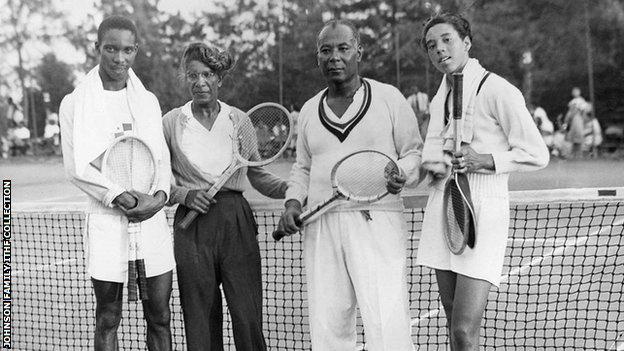
Washington's final basketball game was played in 1942. But this part of her story speaks of a different kind of decline.
When she began her basketball career in the '20s, the women's game was played according to the same rules as the men's. It was fast, competitive and physical.
But by the mid-1930s things were beginning to change, with many of the college teams that formed the women's basketball landscape both in Black and in white sports moving towards what's known as 'participation play', focusing on group exercise rather than competitive action.
In Washington's earlier career, women's basketball often took up around a third of the sports pages in the Philadelphia Tribune. By 1942, when Washington stepped away from the game at the age of 43 or 44, it had reduced to a trickle. That same year, the Tribunes women's team folded.

In 1950, the US census reports that Washington was sharing an apartment in Philadelphia with her brother Larry. She was still working in domestic service.
We know Washington was always close with her family. But family seems to become even more central to her in later life. She co-owns this apartment with her sister, there is a cousin close by, and her young nephew JB Childs also spent time living in the same building.
Years later he hinted to historian Pamela Grundy that his aunt was in a relationship with a woman. As far as we know, Washington never came out publicly, but we believe her sexuality is an important part of her story - and we'll hear from another of her relatives shortly.
Childs also told Grundy about trips back to the farm in Virginia, times of great celebration and joy that are remembered by two other family members in their contribution to our podcast series, Washington's great nephew Gregory Price and her great niece Patricia.
But in terms of her place - her rightful place - in sporting history and the public consciousness, that began to slip away. So much so that when in 1976 the Black Athletes Hall of Fame sought to honour her, they didn't even know she had died.
In 1969, two years before Washington's death at the age of 72 or 73, she was interviewed by Len Lear for a story with the Philadelphia Tribune. They met back where it all began for her: at the Germantown YWCA. Lear, now a veteran reporter for that newspaper, had never heard of her.
"Once I met her and asked a lot of questions, I was absolutely floored," he says.
"It's just hard to imagine this today when you see people like Serena Williams, for example, making countless millions and having their name on perfume and all kinds of other products. And she had nothing. Nothing.
"She was getting old and she was not in great health, but to learn that she was possibly the best female athlete in the country in the first half of the 20th century [and] she was doing housekeeping…
"She did not express anger or rage specifically. She was more or less, I would say, sad. Over what could have been and should have been.
"She wanted to be recognised for her skills by everyone, and she wasn't."
Washington's great nephew Gregory Price has another view. He doesn't remember her as sad.
"My sister and I are essentially the last living members of our families who knew her personally, who had actual personal contact with her. We're the last of that," he says.
"You know, she seemed looming large, larger than life. She was tall and slim, she had a baritone voice and beautiful eyes. And when she looked at you, you saw sincerity in her eyes when she spoke.
"My aunt Ora was homosexual, we had no problem with her sexuality… [but] she was reclusive because of that, so I would imagine those who knew of her sexuality suppressed her accomplishments when she was at her best. They refused [to], even the Black community, let alone the white community because of racism back then.
"They adored her as a player but off the court they refused to acknowledge her because of her sexuality. If she was alive today to see the changes that have taken place - racially, ethnically, sexually, she would be proud to say stand up and say: 'Yes, I'm gay.'
"This is nothing short of a hidden figure story. Someone who played two sports at the highest level, was a champion in both of those sports. [Larry] Bird, [Michael] Jordan, Magic [Johnson]… none of those guys can speak to that. Nobody in sports history.
"Anyone after us, they'll only know her through stories we now tell. I feel like that's my call to action.
"Tell the story, and the facts will speak for themselves."

- The champion of two courts ignored by the world: Ora Washington fought to make her name in racially segregated America
- 'We bleed craft beer': Can BrewDog's CEO steer the Good Ship through the storm of controversy?


































